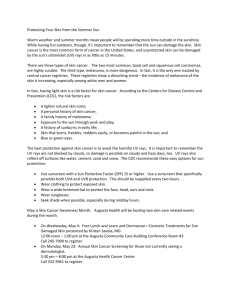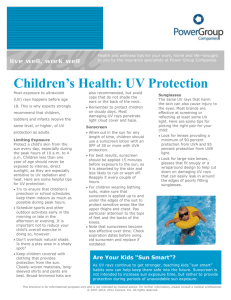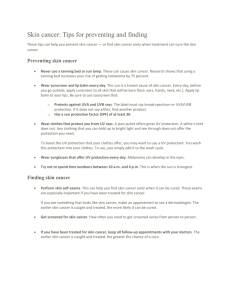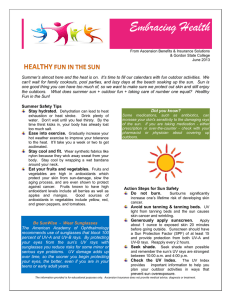Fact Sheet Skin Cancer 2010
advertisement
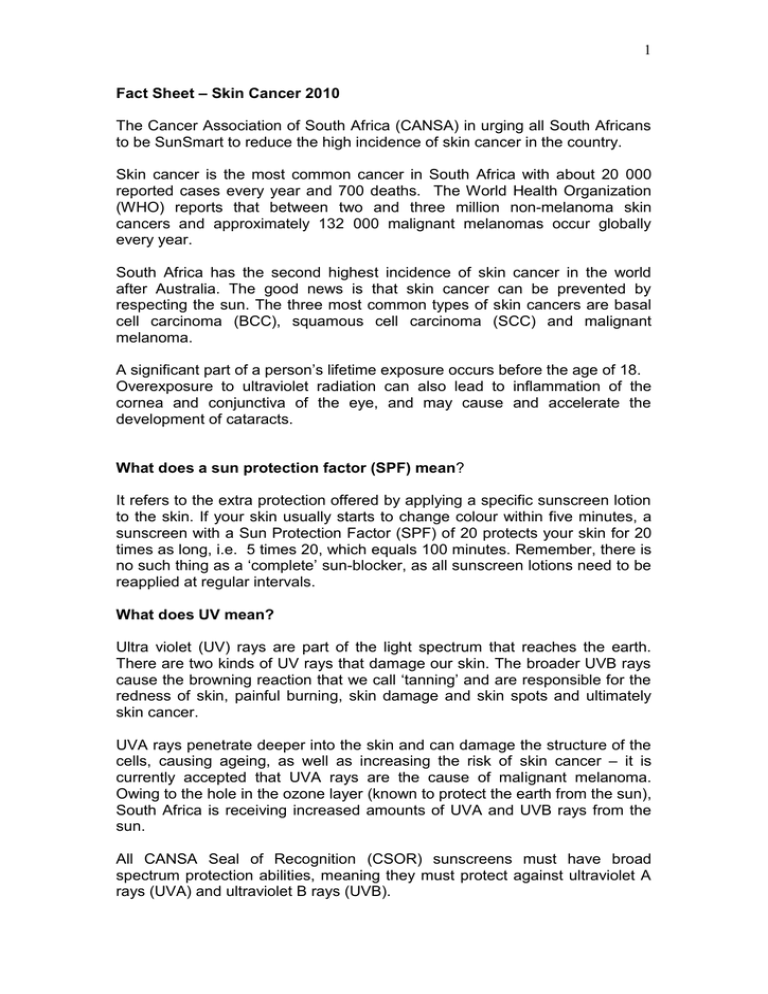
1 Fact Sheet – Skin Cancer 2010 The Cancer Association of South Africa (CANSA) in urging all South Africans to be SunSmart to reduce the high incidence of skin cancer in the country. Skin cancer is the most common cancer in South Africa with about 20 000 reported cases every year and 700 deaths. The World Health Organization (WHO) reports that between two and three million non-melanoma skin cancers and approximately 132 000 malignant melanomas occur globally every year. South Africa has the second highest incidence of skin cancer in the world after Australia. The good news is that skin cancer can be prevented by respecting the sun. The three most common types of skin cancers are basal cell carcinoma (BCC), squamous cell carcinoma (SCC) and malignant melanoma. A significant part of a person‟s lifetime exposure occurs before the age of 18. Overexposure to ultraviolet radiation can also lead to inflammation of the cornea and conjunctiva of the eye, and may cause and accelerate the development of cataracts. What does a sun protection factor (SPF) mean? It refers to the extra protection offered by applying a specific sunscreen lotion to the skin. If your skin usually starts to change colour within five minutes, a sunscreen with a Sun Protection Factor (SPF) of 20 protects your skin for 20 times as long, i.e. 5 times 20, which equals 100 minutes. Remember, there is no such thing as a „complete‟ sun-blocker, as all sunscreen lotions need to be reapplied at regular intervals. What does UV mean? Ultra violet (UV) rays are part of the light spectrum that reaches the earth. There are two kinds of UV rays that damage our skin. The broader UVB rays cause the browning reaction that we call „tanning‟ and are responsible for the redness of skin, painful burning, skin damage and skin spots and ultimately skin cancer. UVA rays penetrate deeper into the skin and can damage the structure of the cells, causing ageing, as well as increasing the risk of skin cancer – it is currently accepted that UVA rays are the cause of malignant melanoma. Owing to the hole in the ozone layer (known to protect the earth from the sun), South Africa is receiving increased amounts of UVA and UVB rays from the sun. All CANSA Seal of Recognition (CSOR) sunscreens must have broad spectrum protection abilities, meaning they must protect against ultraviolet A rays (UVA) and ultraviolet B rays (UVB). 2 CANSA Seal of Recognition (CSOR) The CSOR seal appears on sunscreen products, clothing, swimwear, hats or sunglasses and is your guarantee that the manufacturers of these UV protective products have complied with a strict set of criteria developed by CANSA in the interest of a SunSmart South Africa. Products have to comply with the South African Sunscreen Standard (SANS) 1557:2009 and/ or the Australian/New Zealand standard for fabrics, to qualify for the CANSA Seal. CANSA is currently using two sunscreen testing laboratories in South Africa to test and validate all sunscreens with the CSOR. Their testing methods and criteria are aligned to the recognised international standards and protocols. An international working committee that includes South African representation, is presently developing an international (ISO) standard to rate all UV protection levels for sunscreen. High Risk Exposure Everyone is at risk of getting skin cancer, although people with darker skins are less susceptible because their skin contains more natural melanin that protects against sun damage. People with fair skin, especially those with red hair, moles or skin spots, as well as people with a personal or family history of skin cancer, or who play sport outdoors, work in the sun or spend a lot of time driving, are considered high-risk. At least 80% of sun-induced skin damage occurs before the age of 18 and only manifests later in life. Therefore it is imperative to take special care of children in the sun, whether it is at the pool, on the beach, at play or at school. Babies younger than one year should never be exposed to direct sunlight. When it comes to protecting the young ones, mothers of babies and toddlers; educators and caregivers can play an important role. Sunbeds and tanning booths are not safe There is also no such thing as a healthy tan! CANSA has recommended that the Department of Health ban sunbeds and sunlamps as it has been proven through recent research findings that there is a relationship between the use of sunbeds and malignant melanoma, as well as other non-melanoma skin cancers. Sunbeds predominantly emit UVA and UVB both which can cause damage in the DNA of skin cells. Sunbeds and tanning booths deliver concentrated UVA radiation to unprotected skin and should be avoided at all costs, as it ages skin more rapidly, while putting you at risk of developing skin cancer. According to Professor Werner Sinclair, a dermatologist associated with the University of the Free State: “In general, one can state that the use of an artificial tanning booth will double the melanoma risk of any particular individual.” 3 Spot the Spot Check your skin carefully every month and ask a family member or friend to examine your back and the top of your head. If you notice any of the warning signs, see a doctor or dermatologist immediately. Warning signs A-symmetry - a mole or mark with one half unlike the other - common moles are round and symmetrical B-order irregularities - scalloped or poorly defined edges - common moles have smooth and even borders C-olour variations and inconsistency – tan, brown, black, red, white and blue common moles are usually a single shade of brown or black D-iameter - larger than 6 mm Major kinds of skin cancer There are three (3) major types: Basal Cell Carcinoma and Squamous Cell Carcinoma are common skin cancers. The most dangerous skin cancer is Melanoma. Left untreated skin cancer can lead to death. Basal Cell Carcinoma Raised, translucent, pearly nodules that may crust, ulcerate and sometimes bleed. Occurs most often on the face and other exposed areas, but can appear anywhere. Squamous Cell Carcinoma Usually raised, pink opaque nodules or patches that frequently form ulcers or sores in the centre. Appears most often on exposed areas of the body. Malignant Melanoma Often, small, brown or black, or larger multi-coloured patches with an irregular outline which may crust and bleed. Malignant melanoma may occur in pre-existing moles or skin spots. They can also appear like freckles from previously normal skin. To prevent skin cancer, CANSA advocates the following: Avoid direct sunlight between 10:00 and 15:00 when the sun‟s rays are most dangerous. Stay in the shade or under an umbrella as much as possible. UV rays reflect off cement, water, sand, glass and grass and can therefore cause sunburn in the shade. UV rays are not the same as 4 heat. You can get overexposed even in cool weather - so take care on windy or overcast days. Cover up by wearing thickly-woven hats with wide brims and loosefitting clothes, made of tightly-woven, fabric that is cool, but will block out harmful UV rays. Look out for UV protective swimsuits and beach wear as UV radiation can penetrate fabric. Swimwear and umbrellas bearing the CANSA Seal of Recognition should also be part of your protection kit. Always apply sunscreen with a Sun Protection Factor (SPF) of a minimum of 20 and not higher than 50, to all exposed skin areas, preferably one bearing the CANSA Seal. Re-apply regularly (at least every two hours), after towel-drying, perspiring or swimming. Apply it liberally to all exposed skin; including the back of the neck, tips of ears, arms, feet and hands. The use of sunscreen lotion is not a license to “bare all” in the sun. Go under cover whenever possible, to ensure that you are SunSmart while out in the sun. Protect your eyes by wearing sunglasses with a UV protection rating of UV400. Use lip balm with a minimum of SPF 20 and apply regularly. Avoid sunlamps and tanning parlours. Take special care to protect children - babies younger than one year should never be exposed to direct sunlight. Check your skin regularly for changes, unusual marks or moles. An annual medical examination should include a skin check. Ask a friend to check your back and the back of your legs for spots or changes you may not notice yourself. CANSA‟s SunSmart campaign takes place during the summer months (November to February) and includes talks and exhibitions, as well as visits to schools, holiday resorts and beaches in South Africa. For more information, contact the CANSA toll-free Information Centre on 0800 22 66 22 or email info@cansa.org.za
